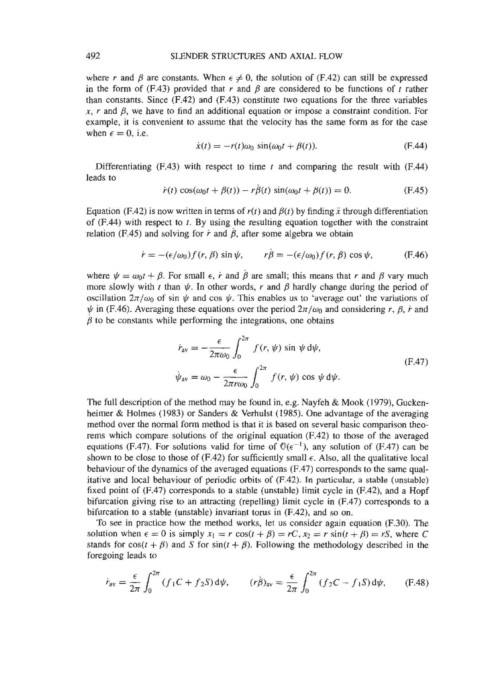Page 522 - Fluid-Structure Interactions Slender Structure and Axial Flow (Volume 1)
P. 522
492 SLENDER STRUCTURES AND AXIAL FLOW
where r and B are constants. When E # 0, the solution of (F.42) can still be expressed
in the form of (F.43) provided that r and B are considered to be functions of t rather
than constants. Since (F.42) and (F.43) constitute two equations for the three variables
x, r and B, we have to find an additional equation or impose a constraint condition. For
example, it is convenient to assume that the velocity has the same form as for the case
when E = 0, i.e.
i(t) = -r(t)wo sin(w0t + B(t)). (F.44)
Differentiating (F.43) with respect to time t and comparing the result with (F.44)
leads to
i-(t) cos(wot + ~(r)) - rB(t> sin(Wt + ~(t)) 0. (F.45)
=
Equation (F.42) is now written in terms of r(t) and P(t) by finding x through differentiation
of (F.44) with respect to t. By using the resulting equation together with the constraint
relation (F.45) and solving for i- and b, after some algebra we obtain
i- = -(E/wO)f (r, B) sin $, rB = -(c/wO)f (r, B) cos $, (F.46)
where $ = mot + ,t?. For small E, i. and b are small; this means that r and B vary much
more slowly with t than $r. In other words, r and #? hardly change during the period of
oscillation 2x/wo of sin l(r and cos $. This enables us to ‘average out’ the variations of
$ in (F.46). Averaging these equations over the period 2n/wo and considering r, p, i- and
to be constants while performing the integrations, one obtains
(F.47)
The full description of the method may be found in, e.g. Nayfeh & Mook (1979), Gucken-
heimer & Holmes (1983) or Sanders & Verhulst (1985). One advantage of the averaging
method over the normal form method is that it is based on several basic comparison theo-
rems which compare solutions of the original equation (F.42) to those of the averaged
equations (F.47). For solutions valid for time of o(t-’), any solution of (F.47) can be
shown to be close to those of (F.42) for sufficiently small E. Also, all the qualitative local
behaviour of the dynamics of the averaged equations (F.47) corresponds to the same qual-
itative and local behaviour of periodic orbits of (F.42). In particular, a stable (unstable)
fixed point of (F.47) corresponds to a stable (unstable) limit cycle in (F.42), and a Hopf
bifurcation giving rise to an attracting (repelling) limit cycle in (F.47) corresponds to a
bifurcation to a stable (unstable) invariant torus in (F.42), and so on.
To see in practice how the method works, let us consider again equation (F.30). The
solution when E = 0 is simply XI = r cos(t + B) = rC, x2 = r sin(t + /3) = rS, where C
stands for cos(t + B) and S for sin(t + B). Following the methodology described in the
foregoing leads to

